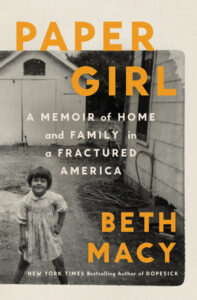
How the Collapse of Local Journalism Led to the Erosion of Community Trust
Beth Macy on the Vital Role of Small Newspapers in Promoting and Maintaining Civic Life
My family had once been proud of me. In March 2011, my sister Terry went to the trouble of stuffing Post‑it notes into every issue of O, the Oprah Magazine in the checkout line of her grocery store, noting, “My sister wrote this article!” After Mom’s death, I inherited a cataloged box of every newspaper and magazine article I’d written, including a scrapbook Grandma Macy made of my honor roll mentions, a newspaper photo of me missing a first-base catch, and some awful stories I’d written for The Urbana Daily Citizen as a college intern. Apparently, during the week of the Champaign County Fair—which is still the biggest happening in Urbana—I was so low on the reporter totem pole that my beat assignment was sheep. (A headline on one of my stories: Michele Meyers Reins [sic] As Lamb and Wool Queen.)
In 2021, Cookie reminded her church friends to watch the Hulu show based on my book Dopesick, only to cringe at the gay storyline and multiple f‑bombs in the first episode. I know this because she accidentally included my husband in a damage‑control message she sent to her friends: “No nudity so far. But if Beth wasn’t my sister, I would not be watching. I probably won’t finish.”
I had settled in a medium‑sized Virginia city, lived for a time in Boston and New York. My siblings all lived in rural places within half an hour’s drive of our hometown. I worked for newspapers and then wrote books, and they no longer believed “the media” unless it came from Fox News or, in Cookie’s case, Newsmax. The newspapers they’d once read had become skeletons of their former selves, their content reduced to crime, high school sports, and ads for gun shows and shooting ranges.
As long as there are incentives for politicians and platforms to keep feeding the outrage industry, gone is the coverage that once held neighborhoods together.
When our eldest son announced he was getting married to the young man he’d been living with for two years, Tim and Cookie ignored it at first. My sister Terry offered a single like on Facebook. She had married John, an early computer tech and champion Hillary‑hater. Whenever I asked John how he was doing, he replied, “deplorable,” and the peacemaker Terry would scold, “We already discussed this, John; no politics!”
When a fellow patron at their small‑town library overdosed in the bathroom in 2017, John was stunned. He’d been watching Fox News obsessively for a decade and no longer took the local paper, so he had little inkling that heroin had arrived in their small Ohio town, until he heard the thump in the bathroom stall.
*
An army veteran who worked as a technician on the manned Apollo 7 mission in Spain, John retired in the early 1990s and spent hours listening to Rush Limbaugh every day. The internet and twenty‑four‑hour cable news were exploding at the time, and measured political debate and news you can use were soon replaced by stories that favored shock value and partisan rancor. Political fevers heightened with the near‑constant barrage of national cable news, usually spun by left‑ or right‑leaning media and amplified by taunting tweets. As Craigslist, Google, and Facebook usurped most of what newspapers counted on for ad revenue, my beloved industry cratered in all but the urban power centers. Non‑city people like John began identifying more with national politics and less with their geographic communities and the kinds of shared narratives that once dominated newspapers, including feature stories that explained who your neighbors were—and sometimes who you were—warts and all.
Those feature articles were the bread and butter of my twenty‑five‑year newspaper career in Roanoke, Virginia, where I still live. I wrote about everything from artists to caregivers for the elderly to a Congolese immigrant who drove the city’s immigrant kids to school.
For eight years I witnessed the travails of a young Black woman born into poverty. Salena Sullivan wasn’t just the first in her family to go to college; she was the first in her neighborhood to go. I was with her at the library counter where she worked after school when she learned she’d been accepted, with a full ride, to Harvard. I got to witness the scene as her longtime library patrons, many of them elderly and former civil rights leaders, put down the newspapers they were reading and wept. And I followed Salena to Harvard the following year, after winning a Nieman Fellowship for Journalism for my work on outsiders and underdogs—one of only two from our class of war correspondents and urban‑based national reporters who hailed from smaller news outlets.
My newspaper pay was lousy. When I quit The Roanoke Times to write books in 2013, none of us had received a raise in eight years. But traveling outside my zip code to witness the breadth of my community and explain it to readers was a joy most days, and it felt like public service. As James Baldwin put it, “The world changes according to the way people see it, and if you can alter, even by a millimeter, the way a person looks at reality, then you can change it.”
When my first story ran, titled “The Library’s Child,” as Salena’s patrons called her, a local hairdresser who was white and gay created a college spending‑money fund in her name. He didn’t want her to feel like a food‑stamp recipient in line at a Whole Foods. This, too, is why local newspapers were once society’s glue.
At The Roanoke Times, the newsroom had 125 employees when I joined in 1989. Now it has six reporters and an editor, Brian Kelley, who routinely works seventy hours a week; his bosses at Lee Enterprises have him regularly laying off reporters and editing three smaller papers in the chain as well. He could retire if he wanted to, but the responsible Eagle Scout in him will not abandon the ship, even though his corporate overlords long ago abandoned him. Before Brian, my favorite editor, Carole Tarrant, was escorted out of the building by a security guard when Berkshire Hathaway bought the paper in 2013. Warren Buffett’s people thought she made too much money, not understanding that she loved journalism so much, as her successor does, that she would have worked for less pay. She was tough as hell, a Philly‑bred redhead who thought nothing of drawing a line of ZZZZZZs on my story drafts to indicate boredom.
But when a Virginia Tech shooter killed thirty‑two students and himself in 2007, Carole worked two months straight, brought in counselors and massage therapists, and created a pay‑it‑forward care system for journalists in other markets who were increasingly covering mass shootings and experiencing secondary trauma.
On the way home from her dismissal, with her work belongings stowed in her trunk, she stopped to cry in my backyard. Ten years later, she still mourns what’s happened to journalism, and her displacement from it, every day. When I told Carole that Brian had canceled an interview with me at the last minute—he said he was just too depressed—she said, “Every day I read the paper and wonder how he’s keeping it together by threads.” At 125,000 subscribers in 1989, The Roanoke Times often had among the highest penetration rates in the nation. In its last publicized circulation count, it sold fewer than 11,000 copies a day (20,429, counting online subscriptions). For decades we were known as a scrappy paper that punched above its weight, with three Pulitzer finalists and scores of national awards. But the capacity that made that possible had all been slashed.
Investigative series and empathy‑building stories like the one about Salena, reported over months and years, rarely appear in local newspapers anymore, which are now largely filled with easier‑to‑land stories about cops and courts, giving the false impression that crime is so rampant that surely everyone ought to run out and buy a gun. In 2022, when the scandal of the Long Island congressman George Santos’s made‑up résumé came to light, press experts gnashed their teeth about The New York Times having missed the story. Turns out the tiny North Shore Leader had broken the news months earlier, but the bigger outlets were either too complacent or too strained to pick it up. And so a wealthy New York suburb, home to Sean Hannity and Billy Joel, elected a con man.
In Carroll, Iowa, a fourth‑generation newspaper publisher named Doug Burns joined forces with the Democratic California congressman Ro Khanna to ask Khanna’s Silicon Valley donors to help Iowa’s newspapers by putting $4 million toward a project to combat misinformation. The goal was for social media companies to atone for the damage they had done to democracy by backing a proposal to push accurate reporting and buoy struggling newspapers. When he was turned down, Burns told a Facebook executive, “When the revolution starts, and we have a civil war in this country, and someone’s dragging you and your family out of your Silicon Valley homes, before the knife goes into you, you’re going to think, maybe I could have stopped this.” Facebook ultimately gave his newspaper a $150,000 grant, and Burns’s nonagenarian mother re‑mortgaged her house, but it wasn’t enough to fight off the onslaught of digital advertising and the demonization of the press. In 2022, the newspaper group that had been operated by Burns’s family for ninety‑three years, Herald Publishing Company, folded as the family was forced to sell The Jefferson Herald and the Carroll Times Herald at a devastating loss.
Khanna told me there should have been a federal policy to tax digital corporations; he’d proposed such a thing under Biden’s “Build Back Better” economic plan, but it didn’t go anywhere. “They were thriving because of content generated by newspapers while at the same time they were displacing them,” turning local news consumers into national news consumers and internet outrage into the reigning version of America’s religion, he said.
This erosion of trust hasn’t just kneecapped the newspaper industry; it’s hit every source of authority that existed when I was born in 1964.
“Facebook needs to be made accountable for its harms,” said Nancy Gibbs, director of Harvard’s Shorenstein Center on Media, Politics, and Public Policy. “The minute one of its algorithms magnifies defamatory or harmful content and it’s monetized, it should not be shielded from liability.”
But a direct line can be drawn from Section 230 of the 1996 Communications Decency Act to online organizers of the January 6 riots, the sexual exploitation of children on sites like Backpage and Pornhub, and illegal online sales of fentanyl and assault weapons. Thus the law, typed out during a naive era of technological optimism, paved the way for social media companies to police their sites for harmful content generated by third parties—but, unlike newspapers and other legacy media operating under good‑faith duty‑of‑care standards, online platforms aren’t required to remove objectionable material and can’t be held liable for socially harmful content on their sites.
“People engage around negative emotions,” Gibbs added. As long as there are incentives for politicians and platforms to keep feeding the outrage industry, gone is the coverage that once held neighborhoods together—not just local investigations, but also editorials and news of local businesses, schools, and neighbors in need and community‑celebrating stories about people like Salena Sullivan (who, by the way, now runs a library and owns a house around the corner from me).
Halfway home to Urbana on one of my visits, I stumbled on something outside a Subway restaurant that reminded me just how low my industry—and the health of our people—had sunk. In Charleston, West Virginia, where the Gazette-Mail won a 2017 Pulitzer for Eric Eyre’s investigation into the corrupt distribution of opioid pills, many of that city’s newspaper boxes had been turned into free “little libraries” offering naloxone and fentanyl test strips. In Sharpie marker, the scrappy harm‑reduction volunteers who man it had written: keep calm & carry naloxone.
Local news once served as democracy’s immune system. As Thomas Jefferson put it, “Were it left to me to decide whether we should have a government without newspapers or newspapers without a government, I should not hesitate a moment to prefer the latter.”
*
The arc of my life parallels an era during which our institutions, including the daily newspaper, have become despised, a time when more than half of Republicans have come to consider reporters “the enemy of the people.”
More than a third of Americans don’t even read the news, and an astonishing number of people from both parties report actual hatred for one another—including 23 percent in 2023 who favored violence should the opposing party win the next election. Unlike newspapers, the digital platforms where many now get their news aren’t held to fact‑based reporting standards.
This erosion of trust hasn’t just kneecapped the newspaper industry; it’s hit every source of authority that existed when I was born in 1964.
__________________________________

Excerpted from Paper Girl: A Memoir of Home and Family in a Fractured America by Beth Macy. Copyright © 2025 by Beth Macy. Published by Penguin Press, an imprint of Penguin Publishing Group, a division of Penguin Random House LLC.
Beth Macy
Beth Macy has won more than two dozen national journalism awards, including a Nieman Fellowship for Journalism at Harvard University, a Guggenheim Fellowship, and a Los Angeles Times Book Prize for Dopesick, which was made into a Peabody Award-winning series for Hulu. Three of her books have been New York Times bestsellers. She lives in Roanoke, Virginia.



















